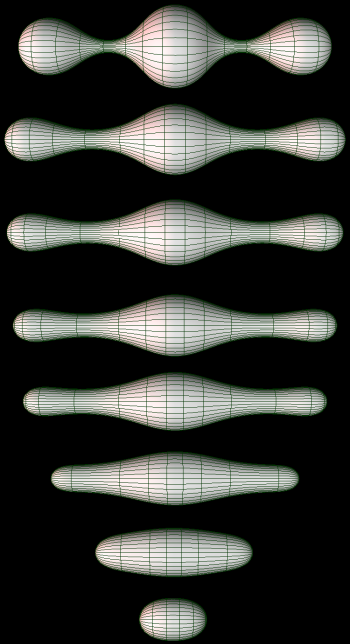
Differential geometry is the study of space geometry. Multiple natural phenomena, from the universe expansion to thermal expansion and contraction, can come down to spatial evolution. The two core conjectures in this field, Hamilton-Tian conjecture and the Partial C0-conjecture, had remained as puzzles for more than 20 years.
"Most of the pebbles on the beach are round. They might have had edges and corners at first, but as time goes by and the tide ebbs and flows, their shape will get closer and closer to perfection and standard. But no matter how perfect the evolution is, there might still be some abnormalities, which are called 'singularities' in geometry."
"The Hamilton-Tian Conjecture is that most of the space is perfect, while the size of the 'singularity' can be restricted to a low-dimensional space", introduced by Prof. CHEN Xiuxiong, the founder of the Institute of Geometry and Physics, University of Science and Technology of China (USTC) of the Chinese Academy of Sciences (CAS).
Prof CHEN, alongside with Prof. WANG Bing from USTC, first proved the aforementioned two conjectures.

The serval stages of Ricci Flow on a 2D manifold. (Image cited from https://en.wikipedia.org/wiki/Ricci_flow)
Their paper was split into two parts, the first of which was published in 2017, and the second part of 123 pages was published this year on Journal of Differential Geometry, one of the leading publications in the field of geometry which also published Hamilton's fundamental work about Ricci flow, after a long course of 5 years of developing the theory and 6 years of peer-reviewing since its first submission.
This work emphasized on the weak compactness theory for non-collapsed Ricci flows. It introduced many innovative thoughts and methods, which contributed far-reaching implications in the field of geometric analysis, especially for the studies of Ricci flows.
In fact, many other works have been developed based on this article. For example, a new solution for stability of Yau's conjecture based on the structure theory of Ricci flows was given by Prof. CHEN, Prof. WANG and Dr. SUN Song of USTC with their derivation published in the top journal, Geometry and Topology. Before that, they were rewarded Oswald Veblen Prize in Geometry for their provision of the first solution of stability of Yau’s conjecture.
The theory and methods presented in this article were also applied into a series of works of Prof. WANG and his cooperators in recent years.
The core ideas of this article were generalized to the research of mean curvature flow by Prof. WANG and Prof. LI Haozhao, who solved the extension problem, and the result was published in Inventions Mathematicae.
The cooperated paper by Prof. WANG, Dr. HUANG Shaosai, and Dr. LI Yu, On the Regular-Convexity of Ricci Shrinker Limit Spaces, published on Crelle's Journal, has proved that the limit of non-collapsed shrinking Ricci solitons must be the cone shape defined by Prof. CHEN and Prof. WANG.
Besides, the work, Heat Kernel on Ricci Shrinkers published on Calculus of Variations and Partial Differential Equations by Prof. WANG and Dr. LI, developed several estimates through the study of the heat kernel on Ricci shrinkers, and provided "necessary tools to analyze short time singularities of the Ricci flows of general dimension".
This breakthrough was honored by the reviewer of the journal and the winner of Fields Metal, Prof. Simon Donaldson, who commented, "this work is a major breakthrough in geometric analysis, and it no doubt will lead many other related research projects."
Jane FAN Qiong
University of Science and Technology of China
E-mail: englishnews@ustc.edu.cn
Space of Ricci flows (II)—Part B: Weak compactness of the flows
On the regular-convexity of Ricci shrinker limit spaces
Heat kernel on Ricci shrinkers

86-10-68597521 (day)
86-10-68597289 (night)

52 Sanlihe Rd., Xicheng District,
Beijing, China (100864)

